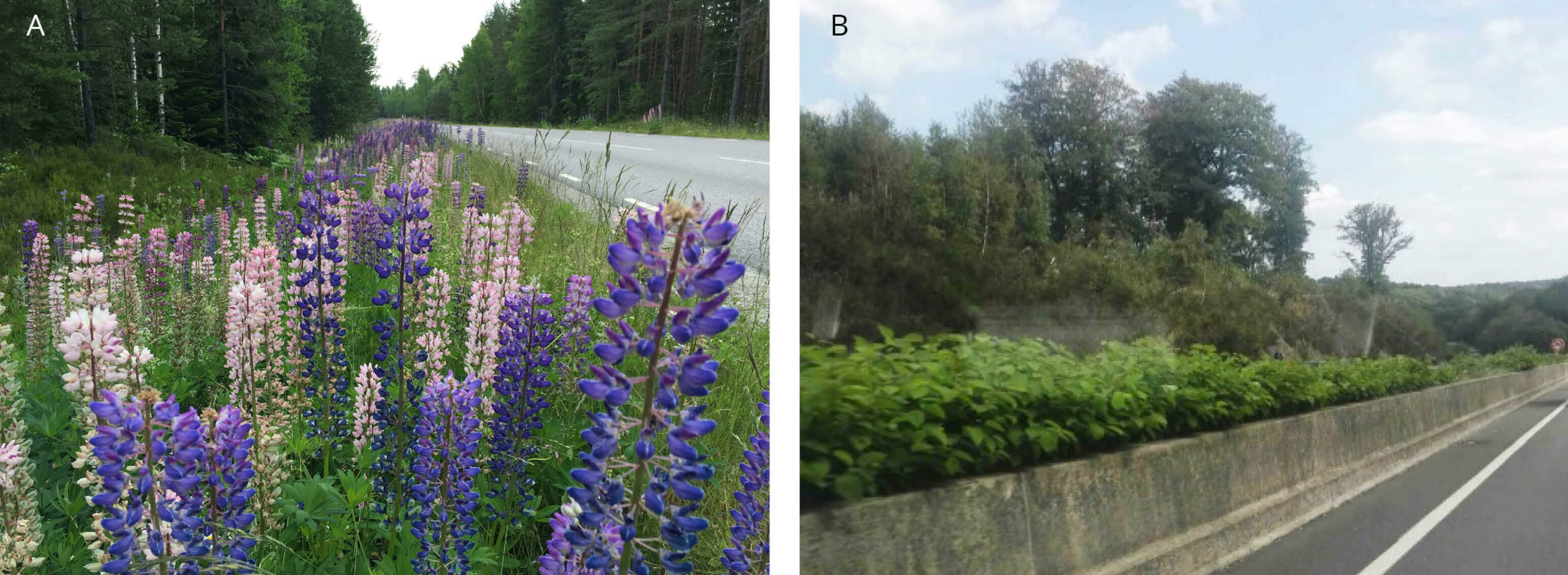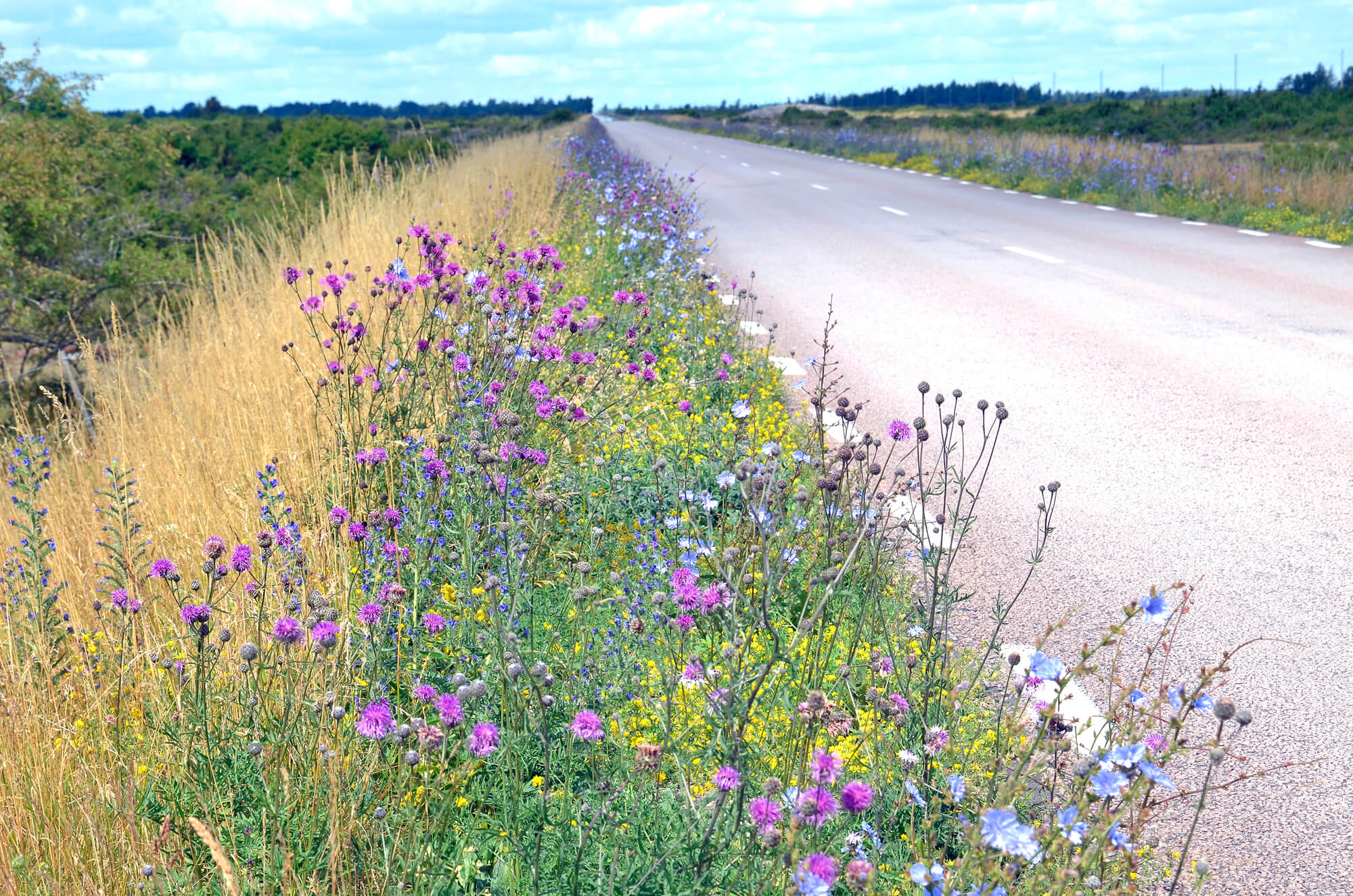The impact created by the transformation of habitats and corridor effect is notable. However, these impacts can be minimised by managing habitats in the infrastructure with biodiversity conservation in mind. HTI are multi-purpose areas alongside roads, railways, under powerlines or at airports. Along roads and railways, they are usually located in the infrastructure ROW. While they are primarily designed to support and secure transportation facilities, they can also play an important ecological role. If managed appropriately, they may:
- Contain the spread of noise, light, or chemical pollution.
- Contain the propagation of IAS and other species of concern.
- Reduce animal mortality and increase traffic safety.
- Provide refuges for rare species.
- Supplement or complement critical biological resources for the survival of local wildlife.
- Create ecological linkages and help species to disperse across an otherwise unsuitable land matrix.
- Embed infrastructure corridors in the ecological network of the landscape.
Most habitats adjacent to infrastructure are managed to maintain an open, grassy vegetation that matches traffic safety constraints and minimise maintenance costs. However, depending on the local conditions such as soil, water level, sun exposure, slope, and adjacent habitats, HTI vegetation may vary greatly, creating a patchwork of areas with different potentials for biodiversity and different maintenance requirements. For example, HTI on sandy, nutrient poor soils may develop into a species- rich, low productive grassland habitats that requires a minimum of maintenance, while HTI on nutrient rich soils will be poorer in species but be highly productive and require repeated mowing with removal of the vegetation remains to prevent succession of bushes and trees.
With the right management (see Chapter 5 – Solutions to mitigate impacts and benefit nature), roadsides can be turned into meadows where wildflowers and wildlife flourish (Figure 1.3.12). Flowery verges on a nutrient-poor substrate may not only appeal to the eye of the people, they can also provide habitat for a diversity of grassland species and hence a resource to many invertebrate species (i.e., pollinators), reptiles, birds, and small mammals that have become rare in the more intensively used agricultural and peri-urban landscapes. Examples include the endangered sand lizard (Lacerta agilis) that benefits from disturbed, dry, open sandy areas that can be found alongside roads and railways in northern and western Europe; and many solitary bees that benefit from flowery roadsides and exert a significant ecosystem service through the pollination of fruit trees and many other agricultural crops in adjacent areas. In addition, cuts from more productive HTI grasslands can be harvested to produce organic matter for local bio-gas production or even for hay or silage. Chemical pollution by salt, lead or poly-aromatic hydrocarbons has declined, but problems with plastic litter have still to be resolved to provide a safe forage for life-stock. By managing HTI to benefit biodiversity, the transport sector can actively support ecological services as well as to provide resources upon which businesses in other sectors may depend.
Ecological traps
The benefits of providing attractive or even viable resources to wildlife within transport corridors must be balanced against the risk of increased mortality and reduced traffic safety due to animal-vehicle collisions. Wildlife mortality due to traffic and infrastructure is a major draw-back and can cause juridical conflicts with the provision of wildlife habitat, especially when involving endangered species (see Section 1.3.2 – Wildlife mortality). Habitats that attract wildlife but pose hidden risks to the survival of the animals are known as ‘ecological traps’. When more animals are killed than what can reproduce, the net gain for biodiversity will be negative. In addition, mortality creates vacancies in local populations. These may encourage individuals from the surrounding habitats to immigrate, only to also be exposed to elevated mortality risks. Thus, HTI may act as a sink, practically draining the landscape of wildlife. This risk is particularly acute for endangered and rare species. Therefore, it is essential to implement measures such as fences or screens to prevent animals from accessing the driveway while they benefit from the infrastructure habitats.
When large mammals such as ungulates or large carnivore are attracted to transport corridors, traffic safety may be jeopardised. Collisions with, e.g., moose in Scandinavia can partly be attributed to the attractive herbaceous vegetation near roads and railroads (Figure 1.3.13); accidents with wild boar in Spain are more frequent in areas where they can scavenge on human litter, while carnivores and birds of prey may visit roadsides and railways in search for roadkill remains. Again, appropriate maintenance of HTI is essential to reduce the appeal of these areas and to avoid ecological traps.

Invasive alien species (IAS)
Verges and other HTI can also facilitate the establishment, proliferation, and dispersal of IAS and other species of concern (Figure 1.3.14). These species can harm native ecosystems, damage infrastructure, and even pose a risk to human health. With increasing human mobility and global trade, aided by climate change, the proliferation of IAS is accelerating and imposing a severe threat to biodiversity.
While common regulatory frameworks and control efforts are in place for some of the most invasive species, the legal situation regarding control liability varies among EU Member States. National lists of IAS also differ due to factors such as climate, land use, and biodiversity management. However, the number of species of concern is growing in most countries. It is crucial to expand our knowledge base to prevent the colonisation of new areas and better control already invaded areas (see Section 5.8 – Invasive Alien Species (IAS)). The transport sector, being a significant pathway for the introduction and spread of IAS, must balance these risks with the benefits of enhancing infrastructure habitats to support native fauna and flora. This calls for more holistic and internationally aligned management plans for biodiversity.
Identifying the first establishments of IAS and other species of concern is essential and this requires a regular and effective monitoring of HTI. A framework to develop ‘early warning systems’ and rapid response has been established by European institutions. This work benefits from new technologies in the transport sector. For example, AI-based image recognition from on-board cameras on cars and trains or from aerial and satellite imagery can offer new and efficient ways to remotely map invasive species and guide eradication efforts.

To conclude, achieving HTI that maximises the desired biological values, minimises the ecological risks, contains the IAS and other species of concern, and ensures the technical function and traffic safety is a complex challenge that involves many stakeholders, including different administrations and planners. This challenge can benefit from international collaboration, frequent exchange of experiences, and a flexible and adaptive management. Moreover, it is a balancing act that requires long-term engagement of landowners and other stakeholders. It is a landscaping task that, although it is the transport sectors’ responsibility, can only be accomplished through interaction with society at large.
